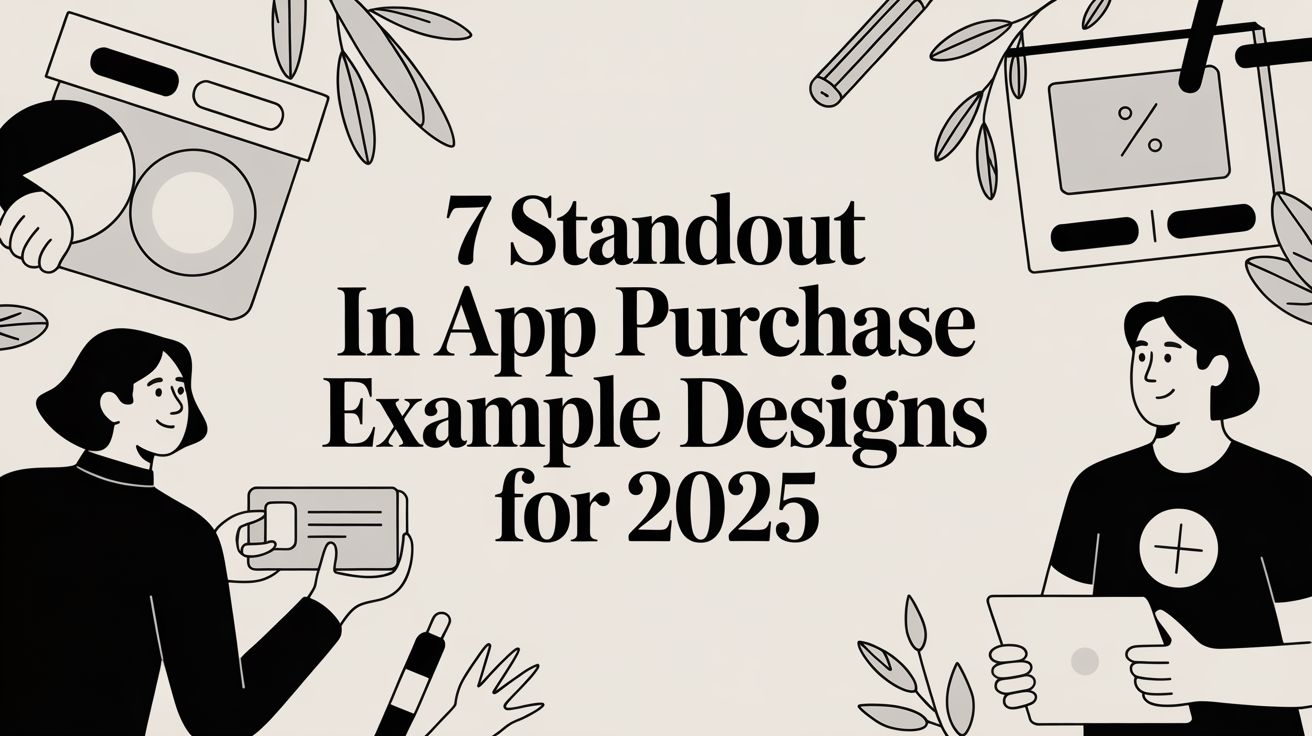
7 Standout In App Purchase Example Designs for 2025
Discover 7 powerful in app purchase example designs and the strategies behind them. Learn from top platforms to boost your iOS subscription revenue.
The jump from a free user to a paid subscriber is one of the most critical moments in an app's lifecycle. A well-designed in-app purchase flow isn't just a transaction gate; it's a powerful, value-driven conversation with your user. Get it right, and conversions soar. Get it wrong, and you risk losing potential customers forever. The difference often comes down to the strategic details in your paywall design, pricing presentation, and overall user experience.
This guide moves beyond generic advice to provide a tactical breakdown of real-world implementation strategies and high-converting designs. We will dissect the resources and platforms that help developers build effective monetization funnels, from official documentation to specialized revenue management tools. For each in app purchase example and platform, you'll find a detailed analysis, key strategic insights, and actionable takeaways you can apply directly to your iOS app.
We'll examine the specific approaches used by leading developer resources and monetization platforms, complete with screenshots and direct links to help you evaluate which tools and methods best fit your needs. This curated list is designed to give you a clear, practical roadmap for optimizing your paywall, improving conversion rates, and transforming casual users into loyal, paying subscribers.
1. Nuxie Gallery: AI-Powered Paywall Innovation
Nuxie Gallery stands out as a forward-thinking resource for developers and product managers seeking inspiration for their next in app purchase example. Rather than a static collection of screenshots, it represents the dynamic output of Nuxie's core AI-powered paywall studio. It serves as a conceptual showcase, demonstrating the platform's ability to generate an infinite variety of on-brand, high-converting paywalls without requiring developers to write a single line of design code.
This resource is designed for teams aiming to move beyond generic templates and implement sophisticated, segment-specific monetization strategies. The Gallery embodies the platform's chat-based creation process, where developers can describe their desired paywall, and the AI generates fully native, customizable variants. This approach dramatically accelerates the design and iteration cycle, making it a powerful tool for modern app development.
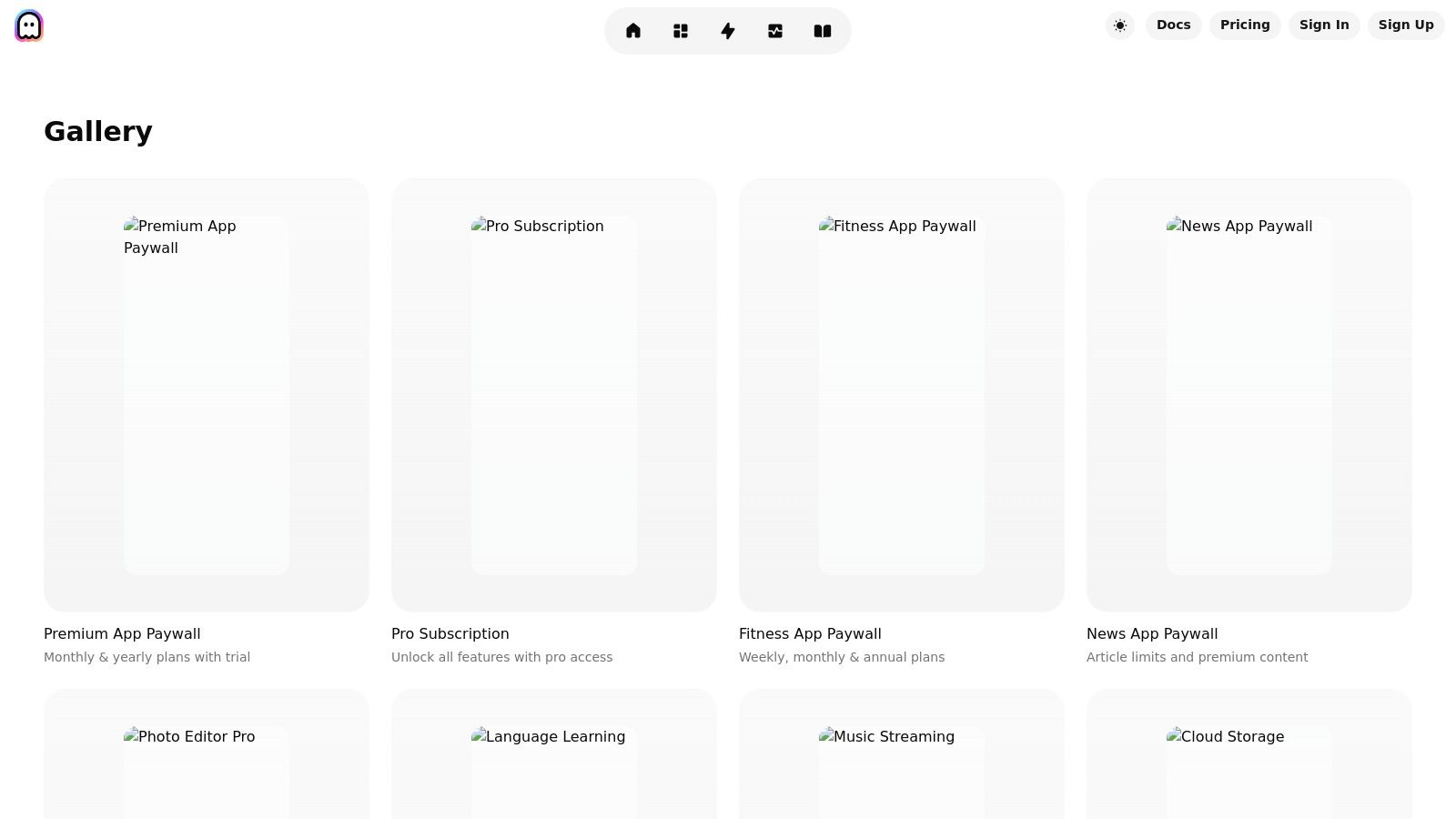
Strategic Analysis: The Power of AI-Driven Iteration
Nuxie's core advantage lies in its AI-native workflow, which fundamentally changes how paywalls are built and tested. The platform decouples paywall management from the app's release cycle, allowing teams to deploy, test, and optimize monetization screens instantly without submitting a new build to the App Store. This agility is critical for responding to market trends and user feedback in real time.
The platform is built with privacy as a foundational principle. By operating with minimal data and ensuring GDPR and CCPA compliance, Nuxie offers a responsible way to personalize paywall experiences. It focuses on contextual triggers rather than invasive user tracking, aligning with modern consumer expectations and platform policies.
Key Insight: Nuxie's true innovation is shifting paywall creation from a technical, code-heavy task to a creative, strategy-driven one. It empowers product managers and marketers to directly influence monetization experiments, fostering a culture of rapid, data-informed iteration.
Tactical Takeaways for Developers
- Accelerate A/B Testing: Use the AI to generate multiple distinct paywall variants for a single offer. Test different value propositions, imagery, and call-to-action buttons simultaneously to quickly identify the most effective design for specific user segments.
- Ensure Brand Consistency: Provide the AI with your app's brand guidelines, including colors, fonts, and tone. It will generate paywalls that feel like a seamless part of your user experience, building trust and improving conversion rates.
- Streamline Collaboration: The shared library feature allows design, product, and engineering teams to collaborate on paywall strategies. Winning designs can be saved and reused across campaigns, creating a centralized system for monetization best practices.
Platform Highlights
| Feature | Strategic Advantage |
|---|---|
| AI-Powered Generation | Instantly create unlimited, on-brand paywall designs using natural language prompts, eliminating design bottlenecks. |
| Live Device Previews | Preview designs across any iPhone or iPad model to ensure pixel-perfect presentation before publishing. |
| No-Code Deployment | Publish paywall updates and A/B tests to live users without needing to push a new app version. |
| Seamless Integrations | Works with RevenueCat, Superwall, or native StoreKit 2, fitting easily into existing subscription infrastructure. |
While the public Gallery page is currently a placeholder, it effectively communicates the platform's potential. Developers interested in this innovative in app purchase example can join the waitlist to access the full paywall studio and begin transforming their monetization approach.
2. Apple Developer – StoreKit
For developers building on Apple's ecosystem, the most authoritative source for in-app purchase examples and implementation guidance comes directly from the source. Apple's Developer portal for StoreKit is less a single app example and more a comprehensive toolkit, offering the foundational patterns, code, and server-side logic required for a production-grade IAP system. It provides the official, up-to-date documentation that all other third-party tools are built upon.
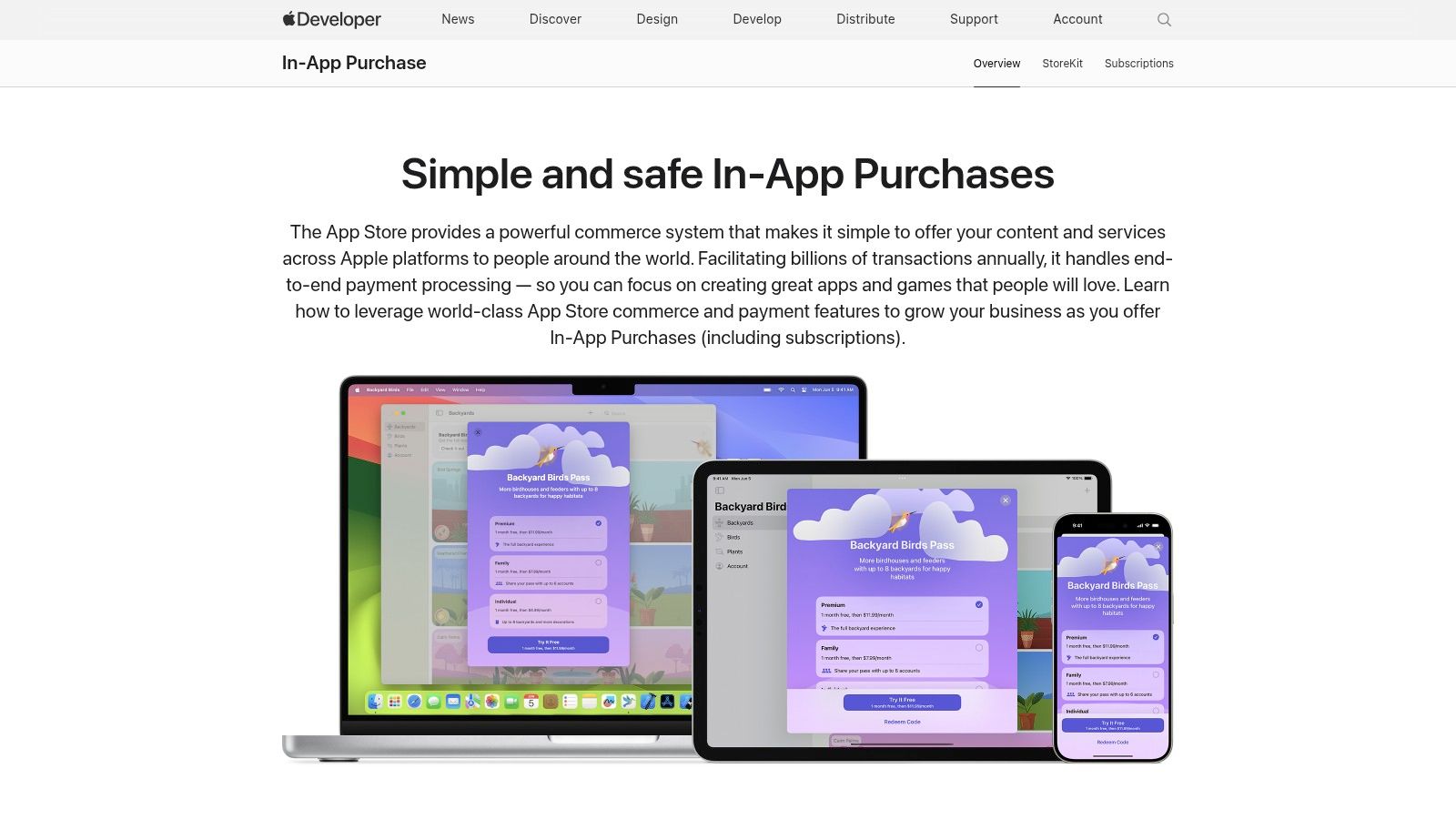
The platform stands out by offering first-party, native solutions that are deeply integrated into the Apple ecosystem. This eliminates guesswork and ensures compatibility with the latest iOS features. For developers seeking a solid in app purchase example, Apple's sample projects and documentation are the gold standard for understanding core concepts.
Strategic Analysis
StoreKit 2, Apple's modern IAP framework, is a significant leap forward. It leverages Swift's modern concurrency features (async/await) to simplify complex transaction logic that was previously prone to errors. This approach drastically reduces the amount of boilerplate code developers need to write.
Key Insight: Apple now provides built-in, pre-made SwiftUI paywall views like
StoreViewandSubscriptionStoreView. This allows developers to implement a fully functional, localized, and compliant paywall with just a few lines of code, significantly lowering the barrier to entry for monetization.
Furthermore, the App Store Server API and near real-time Server Notifications provide a robust backend framework. These tools are crucial for validating purchases, managing subscription states, and handling events like renewals, cancellations, and refunds without relying on the client-side app alone.
Unique Offerings and Features
The resources provided by Apple are extensive and designed for end-to-end implementation.
- StoreKit 2: Modern Swift-based APIs for fetching products and processing transactions.
- SwiftUI Views: Ready-to-use paywall components (
StoreView,ProductView) that adapt to Apple's design language. - Testing Suite: A complete testing environment within Xcode, a sandbox environment for test users, and TestFlight for beta testing.
- Server-Side Tools: The App Store Server API for secure receipt validation and App Store Server Notifications for real-time subscription status updates. It's also vital for processes like enabling a restore purchases feature.
Actionable Takeaways
To leverage Apple's resources effectively, start by exploring their sample code projects. These provide a practical, hands-on understanding of how to structure an IAP implementation. Prioritize using the App Store Server API for receipt validation to build a secure and reliable system that isn't easily circumvented on the client side. Finally, implement Server Notifications to maintain an accurate, real-time record of your subscribers' statuses on your own server.
3. Android Developers – Google Play Billing
For developers targeting the world's largest mobile operating system, Google's official Android Developer portal for Play Billing is the essential resource. Similar to its Apple counterpart, this platform provides the official SDKs, documentation, and best practices for implementing in-app purchases on Android. It serves as the canonical source of truth that all third-party IAP management tools for Android are built upon.
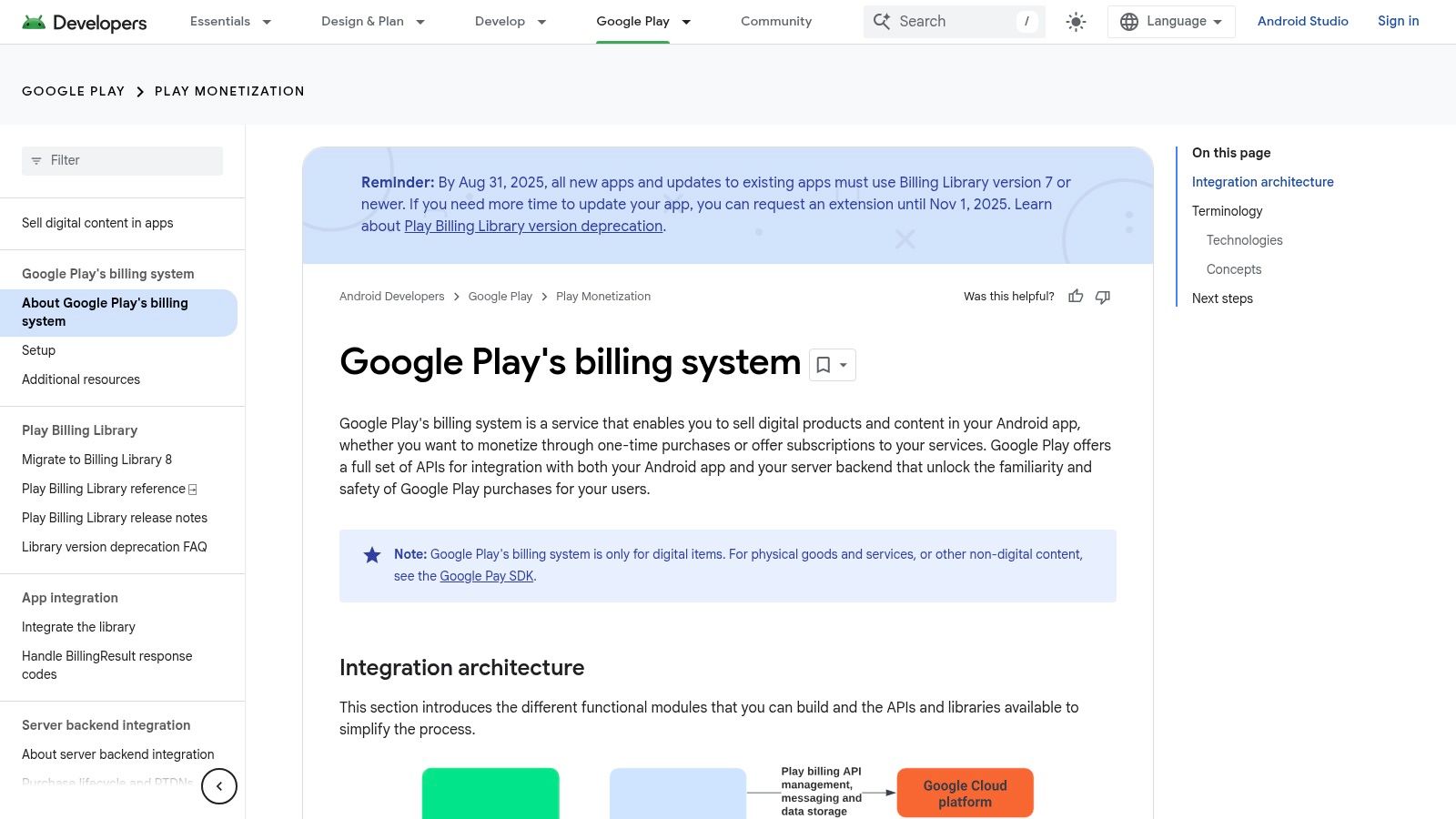
The platform's primary value lies in its direct, first-party integration with the Google Play Store. This ensures that any implementation follows the latest policies and leverages new features as soon as they are released. For any developer looking for a foundational in app purchase example on Android, Google's code samples and step-by-step guides are the definitive starting point.
Strategic Analysis
The Google Play Billing Library has evolved to handle the increasing complexity of modern subscription models. A key structural element is the separation of a subscription product from its "base plans" and "offers." This allows developers to create a single subscription (e.g., "Premium") and attach multiple purchasing options to it, such as a monthly plan, an annual plan, or a special introductory offer, without creating separate product IDs for each.
Key Insight: The Play Billing Library now strongly encourages a server-centric model for purchase validation and subscription management. Relying on Real-time developer notifications (RTDN) via Google Cloud Pub/Sub is critical for maintaining an accurate, secure record of subscription states, independent of client-side events.
This architecture provides immense flexibility for pricing experiments, regional pricing, and promotional campaigns. Furthermore, the server-side APIs for acknowledging purchases and managing entitlements are crucial for preventing fraud and ensuring a reliable revenue stream.
Unique Offerings and Features
The resources from Google provide a comprehensive framework for building and managing Android monetization.
- Google Play Billing Library: The official client-side library for integrating your app with Google Play's billing service.
- Flexible Subscription Models: Sophisticated structure for creating subscriptions with multiple base plans and targeted offers (e.g., free trials, introductory pricing).
- Google Play Console: A web-based interface for configuring products, viewing financial reports, and responding to subscription-related customer issues.
- Real-time Developer Notifications (RTDN): A server-to-server push notification system that provides real-time updates on subscription state changes, such as renewals, cancellations, and grace periods.
Actionable Takeaways
To begin with Google Play Billing, developers should integrate the official sample app provided in the documentation. This offers a working example of the entire purchase flow. It is crucial to set up Real-time developer notifications from the start; this server-side integration is not an optional add-on but a core component of a secure IAP system. Finally, leverage the base plan and offer structure to test different price points and trial lengths to find what resonates best with your audience.
4. RevenueCat
RevenueCat serves as a comprehensive subscription backend, abstracting away the complexities of StoreKit and Google Play Billing. It provides a powerful, cross-platform solution for developers who need to manage in-app purchases without building and maintaining their own server infrastructure. Instead of a single app, it offers a full suite of tools, including SDKs, a REST API, and a robust analytics dashboard, making it an excellent in app purchase example of a managed service.
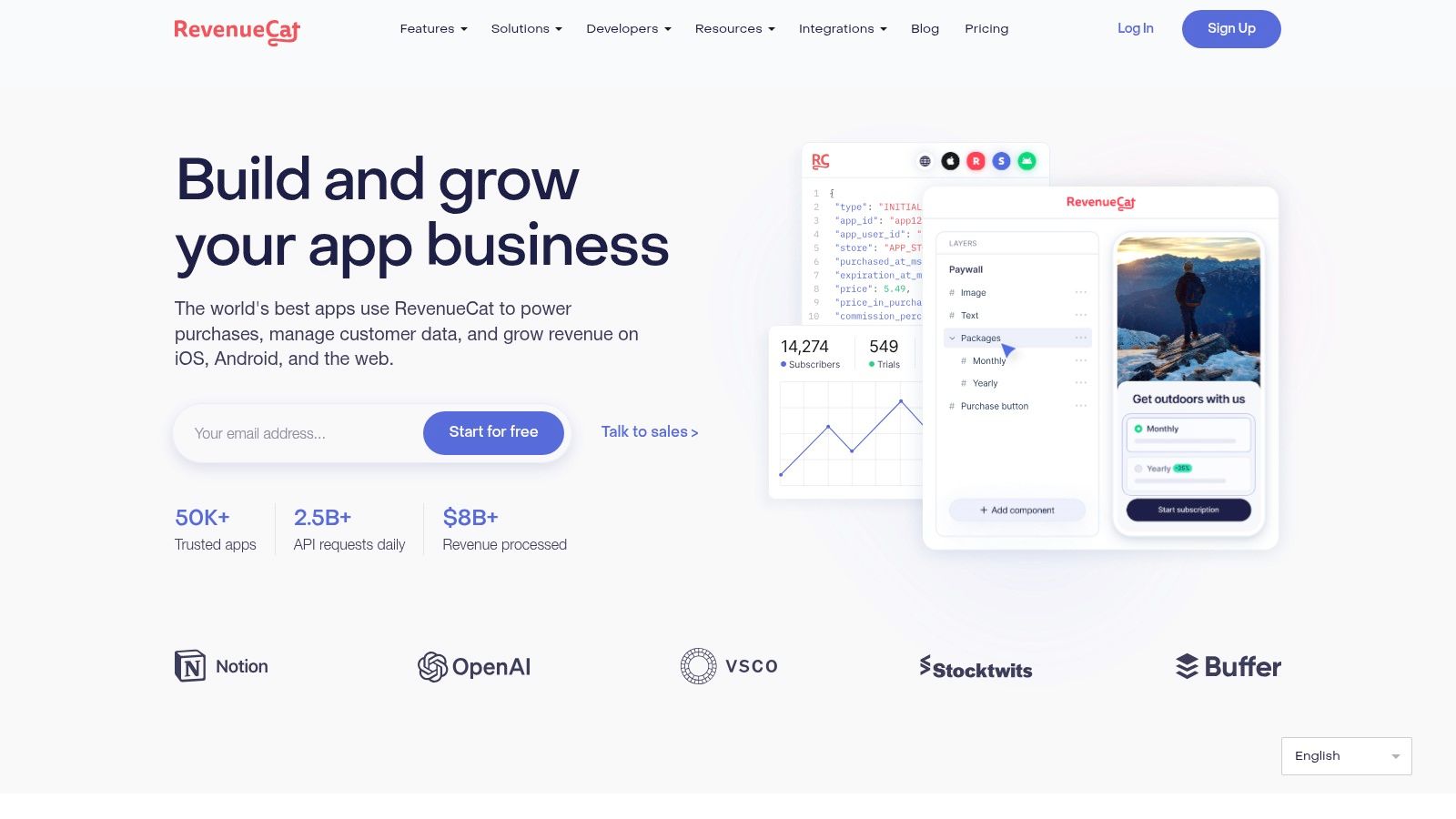
The platform stands out by unifying the purchase logic for iOS, Android, and the web under a single API. This allows developers to manage entitlements and view customer data from one place, significantly simplifying cross-platform development. Its open-source SDKs and detailed documentation make it easy to get started, even for those new to mobile monetization.
Strategic Analysis
RevenueCat's core value is reducing engineering overhead. By handling receipt validation, subscription status tracking, and webhooks for events like renewals or cancellations, it frees up developers to focus on their app's core features. This is particularly valuable for small teams or solo developers who lack the resources to build a dedicated IAP server.
Key Insight: RevenueCat's "Entitlements" system separates what a user has purchased from what features they can access. This abstraction allows product managers to reconfigure offerings, run A/B tests on paywalls, and create new subscription packages without requiring an app update, providing immense flexibility for evolving mobile app monetization strategies.
Furthermore, its built-in analytics provide immediate insights into key metrics like Monthly Recurring Revenue (MRR), churn, and subscriber lifetime value. These tools are integrated out-of-the-box, saving teams the effort of building their own data pipelines for monetization performance.
Unique Offerings and Features
RevenueCat bundles everything needed to launch, manage, and analyze a subscription business.
- Cross-Platform SDK: A unified SDK for iOS, Android, and web platforms like Stripe.
- Entitlement Management: A centralized system for granting and revoking access to premium features.
- Paywalls & Experiments: Remotely configurable paywalls and A/B testing framework to optimize conversion rates.
- Data & Integrations: A suite of charts and analytics, plus integrations with tools like Mixpanel, Amplitude, and AppsFlyer.
Actionable Takeaways
For developers considering RevenueCat, the best first step is to implement their SDK in a new or existing project using the generous free tier. This allows for hands-on evaluation without commitment. Next, leverage the Entitlements system early on to future-proof your product offerings. Finally, connect its data to your existing analytics stack via its integrations to create a unified view of user behavior and revenue performance.
5. Unity In-App Purchasing (Unity IAP)
For developers building monetization into games, Unity’s official In-App Purchasing (IAP) package offers a cross-platform solution designed to streamline the process. Unity IAP acts as a unified API, providing a single codebase to manage purchases across both the Apple App Store and Google Play Store. This abstraction layer is particularly valuable in the game development context, where deploying to multiple platforms is common.
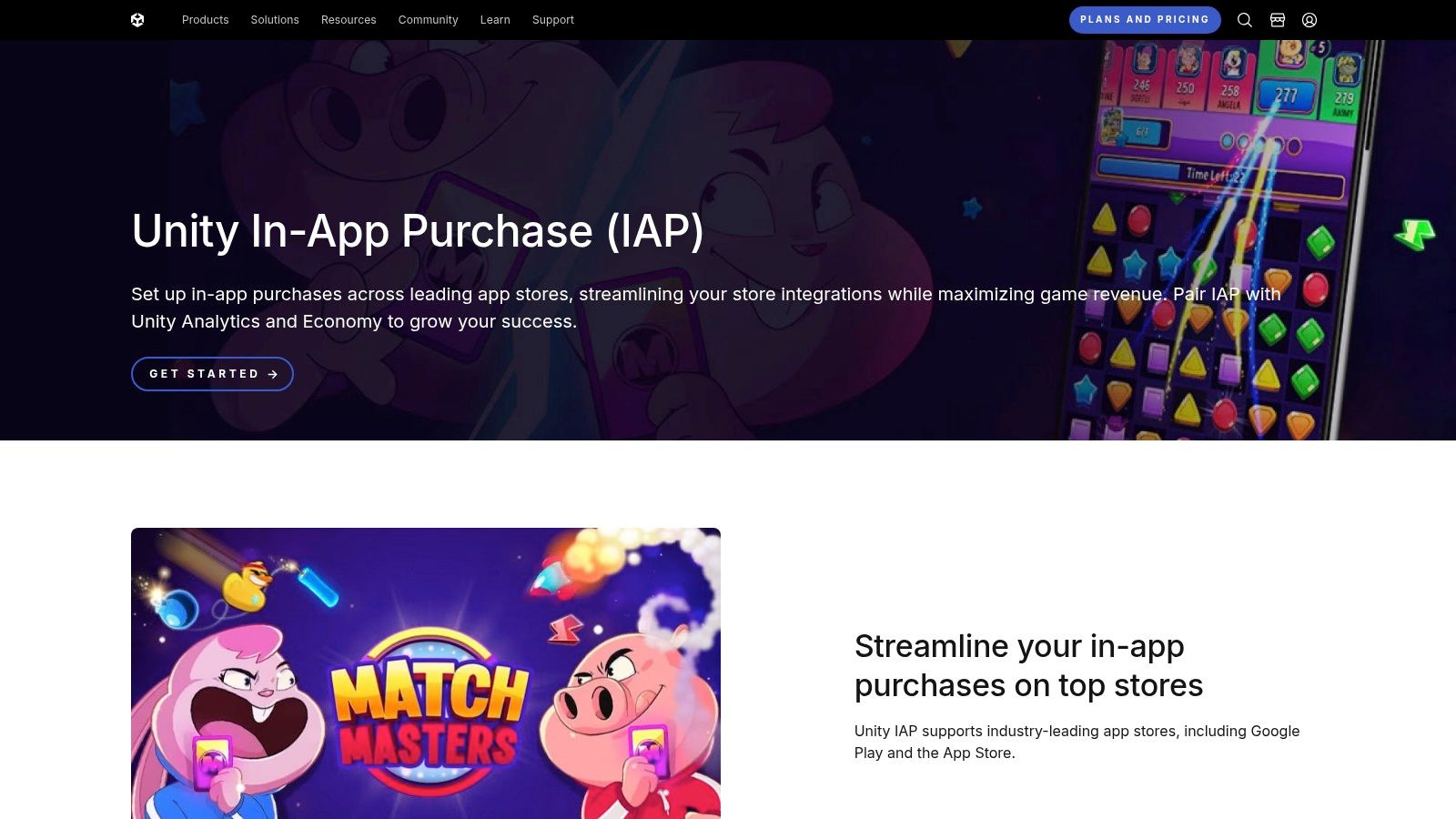
The platform stands out by deeply integrating monetization tools directly into the game engine environment. It offers both code-based and "codeless" IAP setup options, catering to developers of all skill levels. For those seeking a game-centric in app purchase example, Unity's documentation and sample projects provide clear workflows for selling consumables like in-game currency, non-consumables like character skins, and subscriptions.
Strategic Analysis
Unity IAP's primary strategic advantage is its unified workflow, which significantly reduces the complexity of managing platform-specific SDKs. Instead of writing separate IAP logic for iOS and Android, developers interact with a single, consistent API. This saves development time and minimizes the potential for platform-specific bugs, allowing teams to focus on game mechanics rather than monetization infrastructure.
Key Insight: Unity's integration with its own services, like Unity Analytics and Remote Config, creates a powerful feedback loop. Developers can A/B test different price points, analyze purchasing behavior to identify high-value player segments, and remotely update their in-game store offerings without shipping a new app version.
Furthermore, the codeless IAP feature lowers the barrier to entry for non-programmers on a development team, such as game designers or artists. They can configure products, prices, and purchase buttons directly within the Unity Editor, enabling rapid prototyping and iteration of monetization strategies.
Unique Offerings and Features
Unity IAP is bundled with tools specifically tailored for the gaming ecosystem.
- Cross-Platform API: A single set of code to handle transactions on both the Apple App Store and Google Play.
- Codeless IAP: Allows for the setup of IAP buttons and product catalogs through the Unity Editor's user interface, with no coding required.
- Unity Services Integration: Connects with Unity Analytics for purchase tracking and Unity Gaming Services for server-side receipt validation.
- Rich Product Types: Natively supports consumables, non-consumables, and subscriptions, which are essential for modern game economies.
Actionable Takeaways
To effectively leverage Unity IAP, start with the codeless setup to quickly validate your store's user flow and product offerings. Once the concept is proven, integrate the standard IAP API for more complex logic, such as dynamically granting rewards based on purchase type. Crucially, connect your implementation to Unity Gaming Services for server-side receipt validation to protect your revenue from fraud. This ensures that only legitimate transactions are honored within your game's economy.
6. Adapty
Adapty is an in-app subscription infrastructure platform designed to help mobile developers accelerate revenue growth. It moves beyond just managing transactions by providing a powerful suite of tools for building, testing, and optimizing paywalls without requiring constant app updates. This focus on experimentation and remote configuration makes it an essential tool for teams that prioritize data-driven monetization strategies and rapid iteration on their offerings.

The platform’s core value lies in abstracting away the complexities of StoreKit and Google Play Billing behind a unified SDK. For developers looking for a dynamic in app purchase example, Adapty demonstrates how to separate paywall logic from the app's codebase, enabling marketing and product teams to run experiments and deploy changes instantly. This agility is a significant competitive advantage.
Strategic Analysis
Adapty’s primary strategic advantage is its focus on paywall experimentation and optimization. The platform allows for sophisticated A/B/C testing of not just visual designs but also pricing, promotional offers, and product configurations. This is achieved through remote configuration, where paywall content is delivered from Adapty's CDN, allowing for instant updates without a new app store submission.
Key Insight: The ability to segment users and deliver targeted paywalls is a powerful monetization lever. Adapty allows you to show different offers to users based on their country, attribution source, or in-app behavior, dramatically increasing the potential for conversion by tailoring the value proposition.
This approach transforms the paywall from a static, hard-coded screen into a dynamic, server-driven marketing tool. Furthermore, its comprehensive analytics provide deep insights into key metrics like conversion rates, ARPU, and LTV per paywall, which are crucial for making informed business decisions and understanding user behavior. These analytics are also vital for strategies on how to reduce user churn.
Unique Offerings and Features
Adapty provides a complete toolkit for managing and optimizing the entire subscription lifecycle.
- No-Code Paywall Builder: Create and deploy native paywalls using a visual editor with JSON-based templates for full customization.
- Multi-Variant A/B/C Testing: Run tests on paywall designs, copy, prices, and entire product sets to find the optimal configuration.
- Remote Configuration: Instantly update paywalls, products, and promotional offers without submitting a new app version.
- Advanced Analytics: Track real-time metrics, including revenue, churn, renewals, and cohort performance, with integrations into other analytics platforms.
- Cross-Platform SDK: A single SDK supports both iOS and Android, simplifying development for apps on multiple platforms.
Actionable Takeaways
To maximize Adapty's potential, begin by integrating its SDK and replacing your hard-coded paywall with a remotely configured one. Start a simple A/B test immediately, even if it's just changing the headline or call-to-action button color, to familiarize yourself with the workflow. Use the segmentation feature to create a targeted offer for a specific user cohort, such as returning users, to test the impact of personalized promotions. Finally, monitor the analytics dashboard closely to connect paywall performance directly to your key business metrics.
7. Qonversion
For developers looking beyond native frameworks, Qonversion provides a comprehensive cross-platform infrastructure for managing in-app subscriptions and purchases. It serves as a powerful backend-as-a-service, abstracting away the complexities of StoreKit, Google Play Billing, and even Stripe. This allows developers to focus on their app's core features while relying on Qonversion for the heavy lifting of monetization logic.
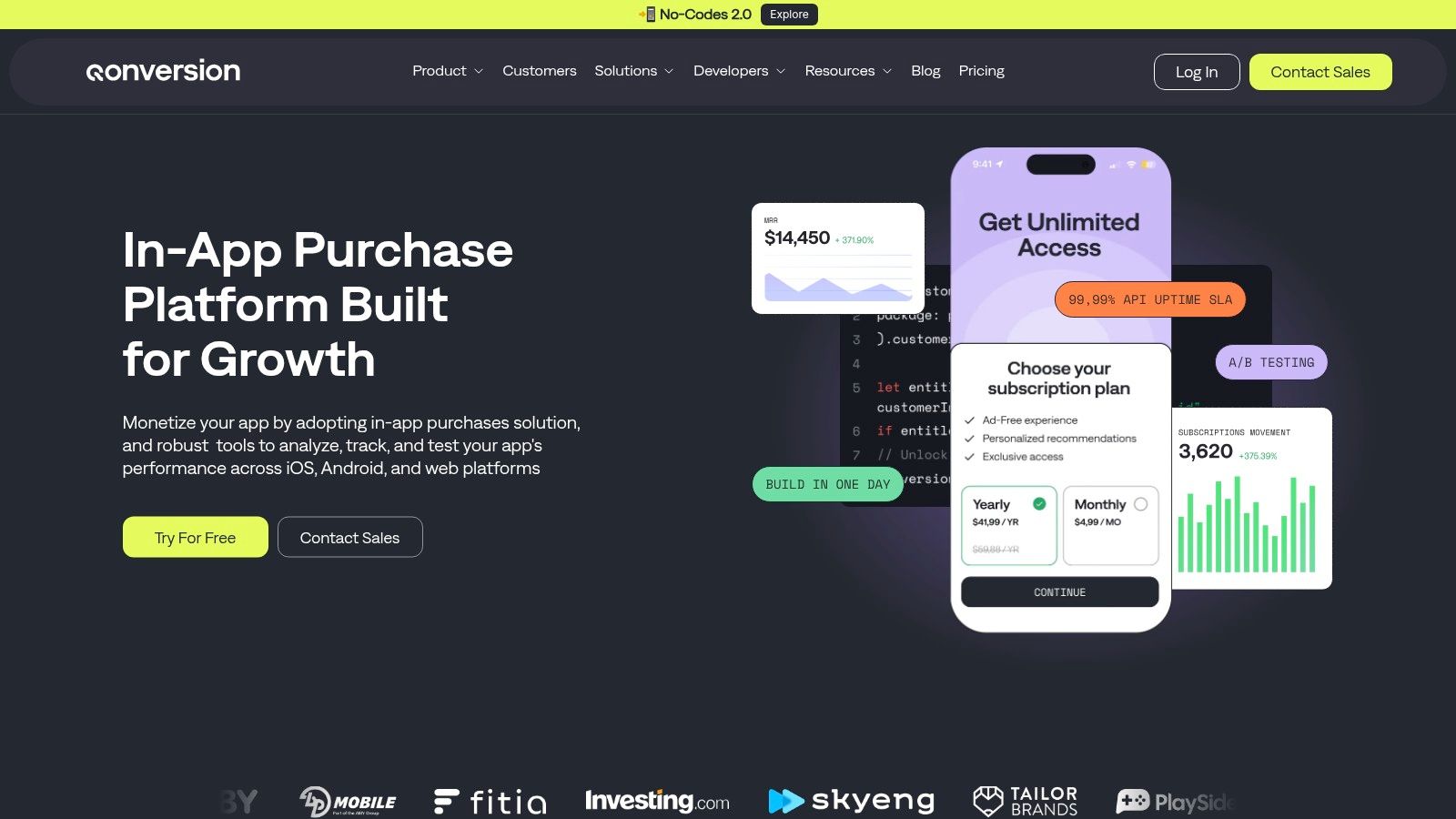
The platform is particularly valuable for teams building for both iOS and Android, offering a unified API to manage entitlements and user access across ecosystems. By providing a single source of truth for user subscription status, it offers a robust in app purchase example of how to scale monetization infrastructure efficiently without building a custom backend from scratch.
Strategic Analysis
Qonversion's primary strength lies in its ability to centralize and simplify the entire IAP lifecycle. It handles receipt validation, manages subscription states, and provides detailed analytics out of the box. This is crucial for developers who need reliable data to make informed decisions about pricing, paywalls, and user acquisition strategies.
Key Insight: The platform's no-code, remotely configurable paywall builder is a significant advantage. It allows product managers and marketers to A/B test different paywall designs, copy, and offers without needing to release a new app update. This agility is a game-changer for optimizing conversion rates.
By integrating with marketing and attribution platforms, Qonversion connects monetization data directly to user acquisition efforts. This allows teams to calculate ROI for different campaigns and channels with much greater accuracy, attributing revenue back to the specific source that acquired the user.
Unique Offerings and Features
Qonversion bundles a wide array of tools designed to accelerate and optimize mobile revenue.
- Cross-Platform SDKs: Unified SDKs for iOS, Android, React Native, Flutter, and more, simplifying implementation.
- A/B Testing Engine: Built-in tools for running experiments on paywalls and product offerings to find the highest-converting setup.
- Advanced Analytics: Provides key metrics like MRR, churn, and LTV, with cohort analysis and attribution filtering.
- Third-Party Integrations: Seamlessly sends purchase events and user data to platforms like AppsFlyer, Adjust, Amplitude, and Mixpanel.
- Entitlement Management: A centralized system for granting users access to premium features, regardless of the platform they purchased on.
Actionable Takeaways
Start by leveraging Qonversion's generous free tier, which supports up to $10,000 in monthly tracked revenue. This is an excellent way to implement a full-featured IAP system in your app with minimal upfront cost. Use the paywall builder immediately to experiment with different value propositions and visual layouts. Finally, connect at least one analytics or attribution integration to gain a holistic view of how your marketing efforts translate into paying customers.
In-App Purchase Solutions Comparison
| Solution | Implementation Complexity 🔄 | Resource Requirements ⚡ | Expected Outcomes 📊 | Ideal Use Cases 💡 | Key Advantages ⭐ |
|---|---|---|---|---|---|
| Gallery | Low to moderate; relies on Nuxie platform integration, no standalone paywall | Minimal developer effort; uses AI-driven design tools | Customized, privacy-compliant paywalls; supports quick iteration and team collaboration | iOS developers seeking AI-assisted paywall design inspiration and campaign testing | AI-powered customization; live previews; seamless team sharing; privacy-first |
| Apple Developer – StoreKit | Moderate to high; requires Apple ecosystem knowledge and coding | Requires familiarity with Xcode, Swift, Apple tools | Production-grade IAP implementation with official Apple APIs and real-time subscription management | Developers building native iOS/macOS in-app purchases | Official, up-to-date, tested by Apple; built-in SwiftUI paywall views |
| Android Developers – Google Play Billing | Moderate to high; Android-specific setup and Play Console configuration | Requires Android Studio, Play Console, API familiarity | Robust Android IAP with subscriptions and offers management | Android app developers implementing Play Billing | Authoritative source with samples; actively maintained with migration tips |
| RevenueCat | Low; drop-in SDK with cross-platform support | Less custom backend overhead, but requires usage cost planning | Simplified subscription management across platforms; analytics and experiments | Cross-platform apps needing backend subscription infrastructure | Cross-platform SDK; reduces server work; active docs and ecosystem |
| Unity In-App Purchasing (Unity IAP) | Moderate; Unity integration with game-specific flows and analytics | Requires Unity environment and potential service costs | Unified IAP for games on iOS and Android with receipt validation and analytics | Game developers using Unity aiming for multi-store IAP integration | Game-focused, unified API; codeless setup; tight Unity Analytics integration |
| Adapty | Low to moderate; no-code paywall builder but vendor tooling to learn | Minimal engineering post-setup; paid pricing tiers based on revenue | Rapid paywall creation, targeting, and real-time experiments to optimize revenue | Teams focused on paywall experimentation and remote updates | No-code paywall builder; A/B/C testing; remote config; strong analytics |
| Qonversion | Moderate; cross-platform SDK and backend integration | Free tier for startups, paid percentage of revenue for scaling | Unified subscription lifecycle with analytics, A/B testing, and data exports | Startups and apps needing cross-platform subscription management and analytics | Competitive free tier; clear feature set; robust experimentation and integrations |
From Insight to Implementation: Your Next Steps in Paywall Design
We've journeyed through a comprehensive landscape of in-app purchase tools and strategies. From the foundational building blocks of Apple’s StoreKit and Google Play Billing to the powerful, data-driven platforms like RevenueCat, Adapty, and Qonversion, a clear pattern emerges. The most effective monetization strategies are not built on intrusive demands for payment; they are built on a foundation of trust, clear value, and exceptional user experience.
Each in app purchase example and tool we analyzed underscores a critical principle: a paywall is not an obstacle. It is a value proposition. Success hinges on your ability to articulate precisely what a user gains and why it's worth their investment, at the exact moment they are most receptive to the offer. The best paywalls feel less like a transaction and more like a natural, beneficial step in the user's journey.
Synthesizing the Key Takeaways
The strategic insights from our examples can be distilled into a few core, actionable principles. These are the concepts you should carry forward as you design or refine your app's monetization flow.
- Clarity is King: Users must instantly understand what they are buying. Vague descriptions or confusing pricing tiers are the primary causes of paywall abandonment. As seen in the best examples, highlighting the most popular plan and using clear, benefit-driven language is non-negotiable.
- Contextual Triggers Matter: The when and where of your paywall presentation are just as important as the what. Presenting an upgrade opportunity when a user hits a feature limit or tries to access premium content is far more effective than a generic, timed pop-up.
- Continuous Iteration Drives Growth: A "set it and forget it" approach to your paywall is a recipe for stagnant revenue. The top-performing apps constantly A/B test everything: pricing, layout, copy, imagery, and even the number of options presented.
Your Actionable Roadmap to a Better Paywall
Translating these insights into tangible results requires a deliberate, step-by-step approach. Instead of overhauling your entire system at once, focus on incremental improvements informed by the examples we've explored.
- Audit Your Current Paywall: Start by evaluating your existing in-app purchase screen against the best practices we've discussed. Is your value proposition crystal clear? Are you using social proof? Is the design clean and focused, or cluttered with distractions?
- Identify Your Tooling Needs: Your choice of tool will define your capabilities. If you are just starting, a platform like RevenueCat can save you immense time on backend infrastructure. If you're focused on rapid visual iteration and A/B testing without constant app updates, a more specialized tool might be necessary.
- Formulate a Test Hypothesis: Pick one element to improve. For instance: "By changing the CTA button text from 'Subscribe' to 'Start My Free Trial,' we believe we can increase trial conversions by 15%."
- Implement, Measure, and Repeat: Use your chosen tools to run the test. Analyze the data rigorously to determine if your hypothesis was correct, and then use those learnings to formulate your next test. This iterative loop is the engine of sustainable monetization growth.
Ultimately, every in app purchase example is a lesson in user psychology and value communication. By adopting a mindset of continuous learning and leveraging the right tools, you can transform your paywall from a simple payment gate into a powerful driver of growth and user satisfaction.
Ready to move from inspiration to implementation? Nuxie allows you to design, build, and deploy native, high-converting paywalls in minutes without writing a single line of code or waiting for app store reviews. Use our drag-and-drop editor to test the very strategies you've learned about today and find what works for your app, faster.